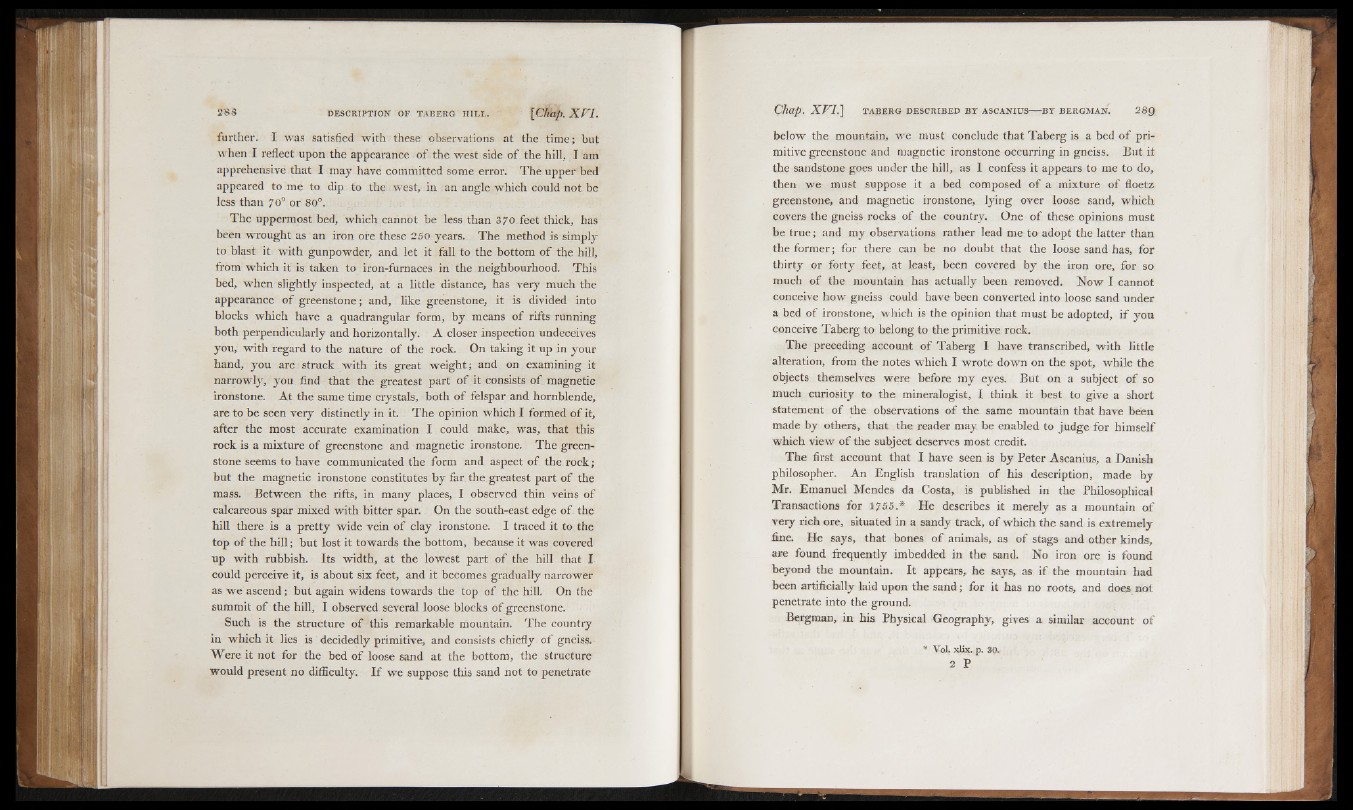
further. I was satisfied with these observations at the time; but
when I reflect upon the appearance of the west side o f the hill, I am
apprehensive that I may have committed some error. The upper bed
appeared to me to dip to the west, in an angle which could not be
less than 70° or 80°.
The uppermost bed, which cannot be less than 370 feet thick, has
been wrought as an iron ore these 250 years. The method is simply
to blast it with gunpowder, and let it. fall to the bottom of the hill,
from which it is taken to iron-furnaces in the neighbourhood. This
bed, when slightly inspected, at a little distance, has very much the
appearance o f greenstone; and, like greenstone, it is divided into
blocks which have a quadrangular form, by means of rifts running
both perpendicularly and horizontally. A closer inspection undeceives
you, with regard to the nature o f the rock. On taking it up in your
hand, you are struck with its great weight; and on examining it
narrowly, you find that the greatest part o f it consists o f magnetic
ironstone. At the same time crystals, both o f felspar and hornblende,
are to be seen very distinctly in it. The opinion which I formed of it,
after the most accurate examination I could make, was, that this
rock is a mixture of greenstone and magnetic ironstone. The greenstone
seems to have communicated the form and aspect of the rock;
but the magnetic ironstone constitutes by far the greatest part o f the
mass. Between the rifts, in many places,. I observed thin veins of
calcareous spar mixed with bitter spar. On the south-east edge of the
hill there is a pretty wide vein o f clay ironstone. I traced it to the
top of the hill; but lost it towards the bottom, because it was covered
up with rubbish. Its width, at the lowest part of the hill that I
could perceive it, is about six feet, and it becomes gradually narrower
as we ascend; but again widens towards the top of the hill. On the
summit of the hill, I observed several loose blocks o f greenstone.
Such is the structure o f this remarkable mountain. The country
in which it lies is decidedly primitive, and consists chiefly of gneiss.
Were it not for the bed o f loose sand at the bottom, the structure
would present no difficulty. I f we suppose this sand not to penetrate
below the mountain, we must conclude that Taberg is a bed o f primitive
greenstone and magnetic ironstone occurring in gneiss. But if
the sandstone goes under the hill, as I confess it appears to me to do,
then we must suppose it a bed composed of a mixture of floetz
greenstone, and magnetic ironstone, lying over loose sand, which
covers the gneiss rocks of the country. One o f these opinions must
be true; and my observations rather lead me to adopt the latter than
the former; for there can be no doubt that the loose sand has, for
thirty or forty feet, at least, been covered by the iron ore, for so
much o f the mountain has actually been removed. Now I cannot
conceive how gneiss could have been converted into loose sand under
a bed o f ironstone, which is the opinion that must be adopted, i f you
conceive Taberg to belong to the primitive rock.
The preceding account o f Taberg I have transcribed, with little
alteration, from the notes which I wrote down on the spot, while the
objects themselves were before my eyes. But on a subject o f so
much curiosity to the mineralogist, I think it best to give a short
statement o f the observations o f the same mountain that have been
made by others, that the reader may be enabled to judge for himself
which view o f the subject deserves most credit.
The first account that I have seen is by Peter Ascanius, a Danish
philosopher. An English translation o f his description, made by
Mr. Emanuel Mendes da Costa, is published in the Philosophical
Transactions for 1755.* He describes it merely as a mountain o f
very rich ore, situated in a sandy track, o f which the sand is extremely
fine. He says, that bones o f animals, as o f stags and other kinds,
are found frequently imbedded in the sand. No iron ore is found
beyond the mountain. It appears, he says, as if the mountain had
been artificially laid upon the sand; for it has no roots, and does not
penetrate into the ground.
Bergman, in his Physical Geography, gives a similar account o f
* Vol. xlix. p. 30.
1 P